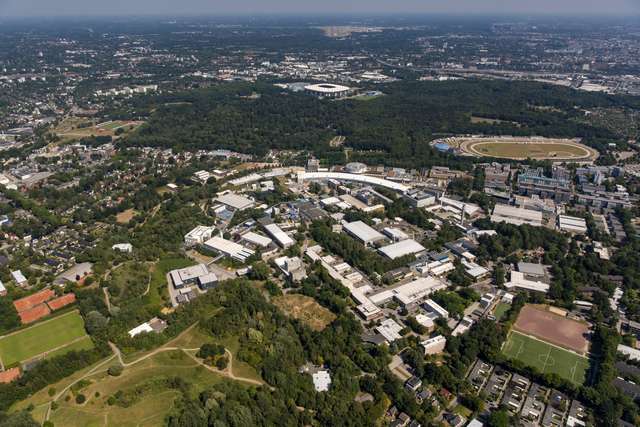Deutsches Elektronen-Synchrotron (DESY)
DESY is one of the world’s leading accelerator centres. Researchers use the large-scale facilities at DESY to explore the microcosm in all its variety – from the interactions of tiny elementary particles and the behaviour of new types of nanomaterials to biomolecular processes that are essential to life. The accelerators and detectors that DESY develops and builds are unique research tools. The facilities generate the world’s most intense X-ray light, accelerate particles to record energies and open completely new windows onto the universe.
That makes DESY not only a magnet for more than 3000 guest researchers from over 40 countries every year, but also a coveted partner for national and international cooperations. Committed young researchers find an exciting interdisciplinary setting at DESY. The research centre offers specialized training for a large number of professions. DESY cooperates with industry and business to promote new technologies that will benefit society and encourage innovations. This also benefits the metropolitan regions of the two DESY locations, Hamburg and Zeuthen near Berlin.

Deutsches Elektronen-Synchrotron in Helmholtz Imaging CONNECT:
Neuroscience is the scientific study of the nervous system (the brain, spinal cord, and peripheral nervous system), its functions, and its disorders. It is a multidisciplinary science that combines physiology, anatomy, molecular biology, developmental biology, …
A branch of biology concerned with the development, anatomy, function, and dysfunction of the nervous system.
Resources used
Neurobiology. In NCI Thesaurus OBO Edition. Retrieved 10:24, February 24, 2022, from http://purl.obolibrary.org/obo/NCIT_C19626
The use of various techniques to directly or indirectly image the anatomy and function of the central nervous system.
Resources used
Neuroimaging. In NCI Thesaurus OBO Edition. Retrieved 10:24, February 24, 2022, from http://purl.obolibrary.org/obo/NCIT_C19626
Pelagic imaging describes studying the ecosystem of the pelagic zone by means of images. Examples here include the studying of e.g. the growth and abundance of various species of plankton in the ocean to get …
See also:
Department of Neuroradiopharmaceuticals: project Flubatine, project VAChT, CB2 project, PDE10, project Sigma 1
Bathymetry (/bəˈθɪmətɹi/) is the study of underwater depth of ocean floors (seabed topography), river floors, or lake floors. In other words, bathymetry is the underwater equivalent to hypsometry or topography. The first recorded evidence of …
At Helmholtz :
Bathymetry at AWIBathymetry at GEOMARBathymetry at UFZ
Diffusion-weighted magnetic resonance imaging (DWI or DW-MRI) is the use of specific MRI sequences as well as software that generates images from the resulting data that uses the diffusion of water molecules to generate contrast …
A diffusion MRI technique in which diffusion-sensitizing gradients are applied to the imaging sequence.
Resource used
http://purl.obolibrary.org/obo/NCIT_C111116
See also:
Electron beam computed tomography (EBCT) is a fifth generation computed tomography (CT) scanner in which the X-ray tube is not mechanically spun in order to rotate the source of X-ray photons. This different design was …
See presentation by Simon Spannagel (DESY) here
The acquisition of images of an anatomic area that is being irradiated using radiotherapy beams and an electronic detector.
Resource usedhttp://purl.obolibrary.org/obo/NCIT_C104994
A technique that monitors blood oxygen level dependent (BOLD) signals to map distant brain regions that work together while performing a task. [Definition Source: NCI]
Resource usedhttp://purl.obolibrary.org/obo/NCIT_C116454
Functional neuroimaging is the use of neuroimaging technology to measure an aspect of brain function, often with a view to understanding the relationship between activity in certain brain areas and specific mental functions. It is …
An imaging modality used to characterize the physiologic, cellular or molecular processes of the central nervous system, particularly in the assessment of neuronal activity.
Resource usedhttp://purl.obolibrary.org/obo/NCIT_C178134
Hard X-ray full-field nanotomography is an ideal technique to study the inner structure of materials non-destructively at high spatial resolution, covering research areas suchas material science, biology and medical research.
(from https://bib-pubdb1.desy.de/record/471334)
In-situ and operando TEM provides a direct link between structural evolution and materials properties or function and the ability to identify transient structures, which cannot be observed ex-situ.
See also:
KIT on In situ EM
Laser Doppler imaging (LDI), also called laser Doppler perfusion imaging (LDPI), is a non-contact optical technique for mapping signals related to microvascular blood perfusion in tissue. It illuminates tissue with coherent laser light and analyzes …
An imaging technique that is used to measure superficial blood flow in the skin.
Resource usedhttp://purl.obolibrary.org/obo/NCIT_C116491
A noninvasive, non-scanning optical imaging technique that provides full-field visualization of blood flow to the tissue being imaged, which provides information about tissue perfusion and the efficiency of disease treatment.
Resource usedhttp://purl.obolibrary.org/obo/NCIT_C116492
A type of magnetic resonance imaging that provides a temperature map of the tissue being imaged.
Resource usedhttp://purl.obolibrary.org/obo/NCIT_C116494
Planar imaging that includes megavoltage images.
Resource used*
http://purl.obolibrary.org/obo/NCIT_C104871
Fluorescence imaging using dyes that fluoresce in the near-infrared range. NIR optical imaging permits relatively deep photon penetration into tissue, minimal tissue auto-fluorescence, less scatter, and high optical contrast.
Resource used
http://purl.obolibrary.org/obo/NCIT_C126402
See also:
A technique in which high-frequency sound waves are bounced off internal organs and the echo pattern is converted into a 2 dimensional picture of the structures beneath the transducer.
Resource usedhttp://purl.obolibrary.org/obo/NCIT_C17230
The Department of Analytics belongs to the Helmholtz Institute Freiberg for Resource Technology, itself part of HZDR.
Helmholtz Imaging (HI) brings scientists and engineers in the Helmholtz Association together to promote and develop imaging science and to foster synergies across imaging modalities and applications within the Helmholtz Association.
A significant amount of …
